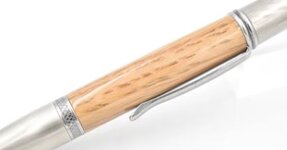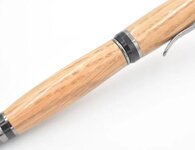Kenobi
Member
Hello there!
I need help with identification of the wood that I have made a pen of. For both, I have used wood that I have scawenged from a transport wooden pallet I have found at work. That dark one is some kind of mahogany, much similar to sapeli ( I have made many pens and other things out of sapeli,I have even more on stock for the future) just with dark pores color, but Im more interested in that light color wood. It smelled like lemons when sanding,but I do not think it is a lemon wood.Any tips?
Thanks in advance!

I need help with identification of the wood that I have made a pen of. For both, I have used wood that I have scawenged from a transport wooden pallet I have found at work. That dark one is some kind of mahogany, much similar to sapeli ( I have made many pens and other things out of sapeli,I have even more on stock for the future) just with dark pores color, but Im more interested in that light color wood. It smelled like lemons when sanding,but I do not think it is a lemon wood.Any tips?
Thanks in advance!


